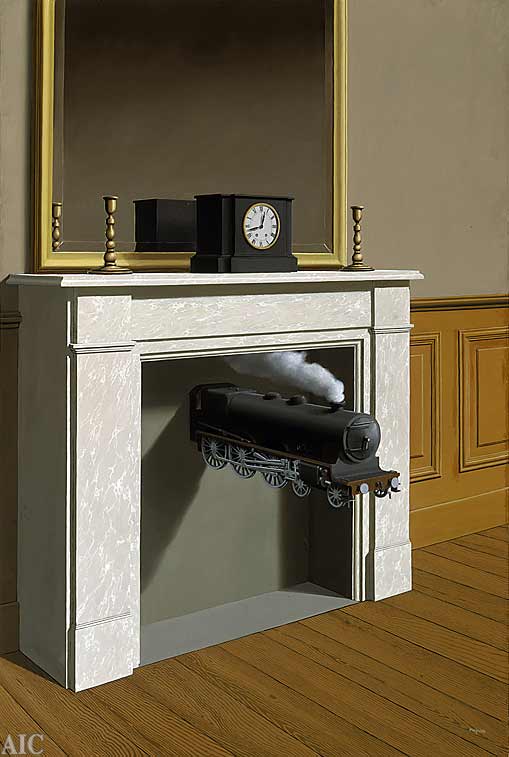René Magritte Gallery
Oil on canvas
147 x 98.7 cm
Joseph Winterbotham Collection, 1970.426, Art Institute of Chicago
The Surrealist movement, which developed in the 1920s, was based on images from the world of dreams and the subconscious. The typical Surrealist device of juxtaposing common objects in unexpected contexts also appealed to the Belgian painter René Magritte. During a three-year stay in Paris, Magritte, whose native city was Brussels, associated with the French Surrealists. Though influenced by the Paris group, he did not share their flamboyant, publicity-seeking tactics. A quiet and thoughtful man who preferred anonymity, he spent most of his career in Brussels, developing a meticulous, realistic painting style that reflected his early training in commercial art, painting false marble and wood paneling for residences.
In explaining Time Transfixed, Magritte said: "I decided to paint the image of a locomotive . . . In order for its mystery to be evoked, another immediately familiar image without mystery — the image of a dining room fireplace — was joined." It is in the surprising juxtaposition and scale shift of these common and unrelated images that their mystery and magic arises. The artist transformed the pipe of a coal-burning stove into a charging locomotive, situating the train in a fireplace vent so that it appears to be emerging from a railway tunnel. The tiny engine races out into the stillness of a sparsely furnished dining room, its smoke neatly floating up the chimney, suggesting in turn the smoke of coal in the stove.

viewer |
|
|
Time Transfixed |
| Voice of Space |
| Human Condition |
| Lola de Valence |
| Lovers |
| Perspective |
| Personal Values |
| Son of Man |
| Alice in Wonderland |
| Tower |
Biography
Bulletin Board
Renowned Art
(home)
René was born in Belgium and in 1922 he married Georgette Berger. In 1925, Magritte painted what he considered to be his first major work, in 1927, he held his first one-man show at the Galérie Le Centaure. He toyed with everyday objects, human habits and emotions, placing them in foreign contexts and questioning their familiar meanings. He rehabilitated the object. He made the commonplace profound and the rational irrational. His work goes beyond escapism and serves to reveal some of the murkier and complex aspects of the human condition.
all artists, with thumbnails: by birth year | alphabetically
all artists: by birth year | alphabetically
artists born in the 13th 14th 15th 16th 17th 18th 19th 20th century